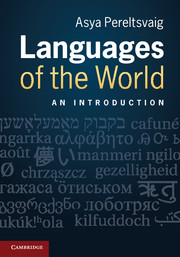Book contents
- Frontmatter
- Contents
- Figures
- Maps
- Tables
- Words, words, words…
- Acknowledgements
- Abbreviations used in the glosses
- 1 Introduction
- 2 Indo-European languages
- 3 Non-Indo-European languages of Europe and India
- 4 Languages of the Caucasus
- 5 Languages of Northern Africa, Middle East and Central Asia
- 6 Languages of sub-Saharan Africa
- 7 Languages of eastern Asia
- 8 Languages of the South Sea Islands
- 9 Aboriginal languages of Australia and Papua New Guinea
- 10 Native languages of the Americas
- 11 Macro families
- 12 Pidgins, creoles and other mixed languages
- Glossary
- References
- Index of languages
- Index of terms
7 - Languages of eastern Asia
- Frontmatter
- Contents
- Figures
- Maps
- Tables
- Words, words, words…
- Acknowledgements
- Abbreviations used in the glosses
- 1 Introduction
- 2 Indo-European languages
- 3 Non-Indo-European languages of Europe and India
- 4 Languages of the Caucasus
- 5 Languages of Northern Africa, Middle East and Central Asia
- 6 Languages of sub-Saharan Africa
- 7 Languages of eastern Asia
- 8 Languages of the South Sea Islands
- 9 Aboriginal languages of Australia and Papua New Guinea
- 10 Native languages of the Americas
- 11 Macro families
- 12 Pidgins, creoles and other mixed languages
- Glossary
- References
- Index of languages
- Index of terms
Summary
In the last section of Chapter 5 we looked at two languages, Maltese and Uzbek, that have some rather uncharacteristic features due to contact with neighboring languages. In this chapter we focus on languages of eastern Asia, a region including China and Southeast Asia and defined in historical terms as the area influenced by Classical China, and we will see that contact among languages again leads to some sharing of grammatical features, creating an impression of a family relationship and descent from a common ancestral language. However, languages of eastern Asia belong to three major language families: Sino-Tibetan, Austro-Asiatic and Tai-Kadai, which will be the subject of the next three sections. In the past, Vietnamese and other languages of Southeast Asia were classified as members of the Sino-Tibetan family; however, their similarities to Chinese are currently credited to language contact by most linguists outside of China, though in the Chinese scholarly community, some of the Southeast Asian languages are still included in the Sino-Tibetan family.
There are also three languages in eastern Asia whose family relationships have not been determined and remain controversial: Japanese, Korean and Ainu. These languages will be considered in more detail in Chapter 11.
- Type
- Chapter
- Information
- Languages of the WorldAn Introduction, pp. 124 - 142Publisher: Cambridge University PressPrint publication year: 2012



